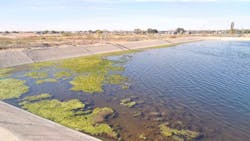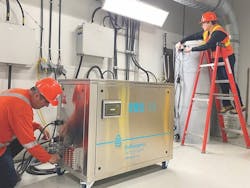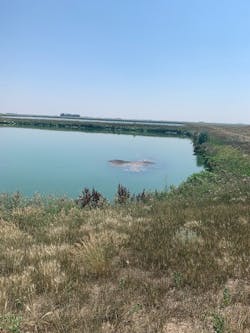About the author:
Suzan Chin-Taylor is CEO of Creative Raven, a specialty marketing and business development firm for the wastewater industry. Chin-Taylor can be reached at [email protected].
Compliance, odor, FOG, H2S damage, capacity limits, and consent decrees. These are just some of the many issues wastewater treatment plant and collection system operators face daily. Now, through advancements in bioaugmentation, many of these issues can be dealt with utilizing one solution that combines natural treatment with science and technology.
A Needed Shift
The use of bioaugmentation in wastewater treatment is nothing new. Changing the form of microbiology and how it is introduced into the system is now making bioaugmentation that solves treatment pain points possible and affordable. The EBS-Di from EnBiorganic Technologies combines the customized proprietary soil microbiology with autonomous delivery technology for a natural, sustainable biological treatment of wastewater.
The EBS-Di unit is 4-ft-by-2-ft-by-3-ft. Through a patent-pending process, it generates and activates customized microbiology just before it enters the wastewater system. This means the microbes are immediately ready to go to work to deliver consistent results. The consortium of microbes is customized to each application. Unlike indigenous microbiology, this facultative anaerobic consortium can perform without oxygen. It is also highly adaptive, translating to reduced retention time requirements. This, in turn, lowers the cost per volume treated. It generates, activates, adapts, and dispenses EBT-Microbes in one complete package.
The generator grows microbe cultures at a rapid pace, on a massive scale. It is positioned where it can dispense these microbes into a natural or manmade body of water, at a level that overwhelms the inappropriate or problem nutrients or contaminants. It is typically placed at the plant headworks or a lift station in the wastewater collection system at a location identified by a technical team as the most advantageous location to achieve desired outcomes.
All that is required to set it up is a physical footprint to accommodate the equipment, and a reliable electric power source. The unit does not require capital expenditure or additional operational labor and expenses by the end-user. It is provided by through a Technology as a Service (TaaS) model. The unit is remotely controlled and monitored by the technical team and serviced locally by a trained licensed service provider.
Case History: Weyburn, Saskatchewan
In Weyburn, Saskatchewan, a 400-Acre Lagoon Treatment Plant had trouble with sludge removal; disposal costs; fats, oils and grease (FOG); odor control and system capacity.
Over its years of service, this lagoon treatment plant has experienced heavy sludge buildup that had never been completely dredged. The dredging of these cells was quite costly and Weyburn experienced issues being unable to dispose of what was dredged in the typical method as the material contained hydrocarbons and other contaminants that were at a level above acceptable limits for a standard landfill disposal.
In addition to sludge remediation and disposal, Weyburn also experienced a high degree of fats, oils, and grease (fog) buildup in its lift stations that required confined space entry by its operators. However, normal pressure washer spray techniques would not remove the buildup as the FOG was so heavy. Yet, regular cleaning was required to keep lift station pumps and floats in good working order. Odor at the primary lagoon could also be an issue from time to time. Although able to meet compliance permits, Weyburn had remained close to allowable levels and wanted to stay ahead of potential issues.
Weyburn received some benefiting results immediately after the EBS-Di units went online. Within a few weeks, its collection systems operators noticed that in the lift stations where the units were set up, FOG was falling or sliding off the sides of the walls and not sticking or clumping to the pumps and floats as it always had.
Because of this, the operators have not had to enter the lift station to manually clean it whereas previously they were required to perform this task every few weeks. Odors had disappeared in both stations as well.
Prior to the trial beginning some of the lagoons had sludge piles that were above the waterline. Approximately a month into the trial the levels noticeably decreased, and piling was dissipating. It was also noticed that the consistency of it had changed and was appearing fluffy or suspended instead of a fixed solid mass as it had been.
Continuous improvement in the collection system and sludge reduction was proof enough that this was a solution that Weyburn wanted to keep as part of their treatment process, so the city entered a contractual service agreement with multiple extensions. The EBS-Di is provided on a TaaS Model, and did not require any CAPEX or additional OPEX for the city.
Case History: Jal, New Mexico
Struggling with capacity issues, permit compliance, odor control and an imminent CAPEX upgrade, a wastewater treatment plant in Jal, New Mexico, sought solutions.
The city is situated in the center of the Permian Basin, which makes it a key player in accommodating thousands of “roughnecks,” who arrive each year to work in surrounding oil fields.
Its 50-year-old wastewater collection and treatment facilities were beyond their designed service life and with the increased demand from its new long-term visitors, its capacity issue was on the radar of state regulators.
Operators were finding it difficult to keep BOD, TSS and total nitrogen within state requirement range. Moving away from a lagoon system was the obvious choice but costs were prohibitive and some upgrades such as the installation of an infrared system helped but were not able to get Jal into compliance. It appeared the construction of a new plant was imminent, but funding in the range of $20 million was a serious obstacle that would require something to be done in the interim.
A single EBS-Di was installed at the plant’s headworks primary lift station, a location determined by Jal and the EnBiorganic technical team. City Manager for Jal Matt White was skeptical of the proposed results. From July through October, White said he was shocked by the outcome.
Other outcomes for Jal from running the EBS-Di unit included:
- Consistently meeting NMED's Class 1B efficient reuse limits for BOD, TSS and total nitrogen concentrations;
- A fresher odor to the aerated lagoon, typical of a biological activated sludge plant;
- Even settling of lagoon floc that is uniform in size;
- Improved clarity of the Chlorine contact chamber to 2-3 feet, from previously less than 1 foot;
- Reduction in fats, oils, and grease within the splitter boxes; and
- Decreased sludge volumes, which were checked before the trial began and afterwards.
So impressed with the results over several months of compliance, it was decided the city needed to secure the service for three years and Jal has entered into a term contract.



